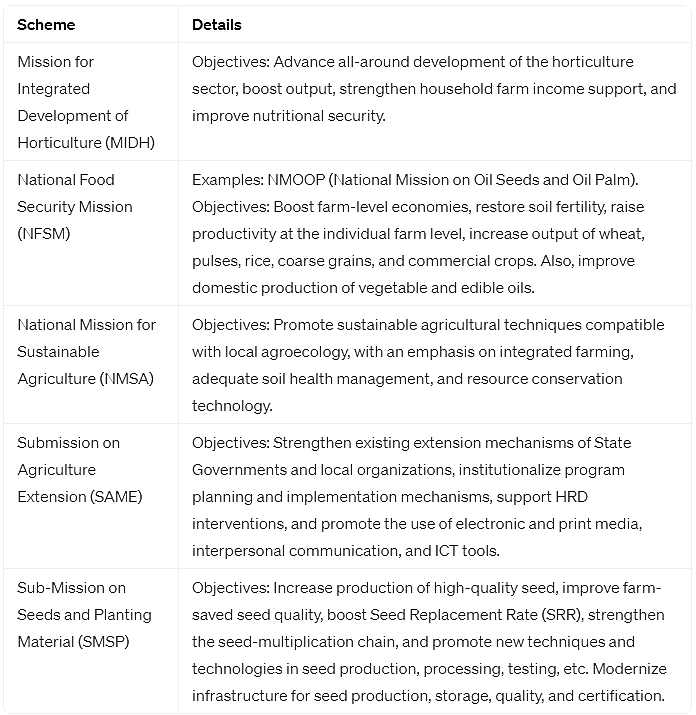Green Revolution in India | Economics Optional Notes for UPSC PDF Download
Introduction
The rapid gains in wheat and rice yields in developing nations caused by improved varieties and increased fertiliser and other chemical input use are known as the “Green Revolution,” which has had a significant influence on incomes and food supplies in many of these nations. William Gaud coined the phrase “green revolution,” and Norman Borlaug is regarded as its founder due to which he was honoured with Nobel Prize in 1970 for developing High Yielding Verities of Wheat.
Green Revolution in India
- Green Revolution in India is the process of boosting agricultural output using contemporary methods and instruments. The Green Revolution is related to agricultural output. It was during this period that the nation’s agriculture was transformed into an industrial system by the adoption of modern agricultural practices such as the use of high-yielding seed varieties, tractors, irrigation systems, herbicides, and fertilizers.
- Up until 1967, the government’s main focus was on enlarging the agricultural areas. However, the rapidly growing population demanded drastic and fast action to enhance yield, which manifested itself in the form of the Green Revolution.
Father of Green Revolution in India
In the year of 1965, the Indian Indian initiated the Green Revolution under the supervision of a geneticist, who is also known as the father of the Green Revolution in India M.S. Swaminathan. Revolution within India led to an increase in food grain production, mostly in the regions of Punjab, Haryana, and Uttar Pradesh. A major landmark in this undertaking was the development of high-yielding varieties (HYV) seeds of wheat, and rust resistant strains of wheat. Personalities and Institutions recognized for their efforts during the Green Revolution in India are,
- Main Architect and the Father of Green Revolution in India – M.S. Swaminathan
- Political Father of Green Revolution and the Food and Agriculture Minister – Chidambaram Subramaniam
- Father of Wheat Revolution – Dilbagh Singh Athwal
- IARI – Indian Agricultural Research Institute
Important Schemes Related to Green Revolution in India
 Green Revolution in India’s History
Green Revolution in India’s History
- The Bengal Famine, which occurred in 1943 and was the worst food crisis ever recorded, caused an estimated 4 million people to die of starvation in eastern India. Even after independence in 1947, the government’s focus on enlarging the agricultural lands persisted until 1967. However, the rate of population growth was outpacing the rate of food production. To boost yield, an immediate and dramatic intervention was required. The Green Revolution served as the catalyst for the action.
- With the assistance of a geneticist also known as the Father of The Green Revolution (India), M.S. Swaminathan, the Indian government began the Green Revolution in 1965. The country’s status was transformed from one of the world’s leading agricultural nations as a result of the green revolution, which was a huge success.
- It began in 1967 and continued until 1978. The term “green revolution” in India refers to a time when contemporary agricultural practices and technology, such as the use of HYV seeds, tractors, irrigation systems, pesticides, and fertilizers, transformed Indian agriculture into an industrial system. India’s Green Revolution increased agricultural output, particularly in Haryana, Punjab, and Uttar Pradesh.
Green Revolution in India Objectives
The Green Revolution in India has several specific characteristics.
- Growth in the size of agricultural areas
- Double cropping systems, or the practice of growing crops twice a year.
- Due to the construction of dams and the adoption of other basic irrigation techniques, water was now obtained from extensive irrigation projects.
- Using high-yield variety seeds that were generated from new strains of seeds with enhanced genetics.
Wheat, rice, jowar, bajra, and maize were the principal crops. Grain products other than food were not included in the new strategy’s scope. For many years, wheat remained the foundation of the Green Revolution.
Green Revolution in India: Positive Effects
- In 1978–1979, a tremendous increase in crop production led to a grain output of 131 million tonnes, making India one of the largest agricultural producers in the world. The area of crops planted with high-yielding wheat and rice varieties increased significantly during the Green Revolution. India was able to become self-sufficient in food grains and occasionally even had enough stock in the central pool to export grains. Additionally, there are now more food grains available per person on a net basis.
- The Green Revolution’s introduction assisted farmers in increasing their level of revenue. Farmers invested their extra money back into their fields to increase productivity. The major farmers who had more than 10 hectares of land gained the most from this revolution because they made significant financial investments in HYV seeds, fertilizer, machinery, etc. It supported capitalist farming as well.
- Large-scale farm mechanization brought about by the Green Revolution in India increased demand for several equipment types, including tractors, harvesters, threshers, combines, diesel engines, electric motors, pumping sets, etc. Additionally, there was a significant growth in demand for chemical fertilizers, herbicides, insecticides, pesticides, etc. Agro-based industries are those that utilize a variety of agricultural products as raw materials.
- Due to fertilizer use and multiple cropping, there was a noticeable increase in the need for labourers. The Green Revolution produced a large number of jobs for both industrial and agricultural employees by building connected facilities including factories and hydroelectric power plants.
 |
Download the notes
Green Revolution in India
|
Download as PDF |
Impacts of Green Revolution in India
- Although the revolution has benefited all food grains, including wheat, rice, jowar, bajra, and maize, other crops including coarse cereals, pulses, and oilseeds have been excluded. Major cash crops including sugarcane, cotton, jute, tea, and cotton were also largely unaffected by the Green Revolution. Only five crops were allowed under the High Yielding Variety Program (HYVP): maize, wheat, rice, jowar, and bajra. Therefore, the new method did not apply to non-food grains. The HYV seeds in the non-food crops either hadn’t been developed yet or weren’t good enough for farmers to take a chance on using them.
- Growing regional and international economic imbalances are a result of the Green Revolution’s technological advancements. Only 40% of the overall cultivated area has been impacted thus far, while 60% is still unaffected. Punjab, Haryana, and western Uttar Pradesh in the north, and Andhra Pradesh and Tamil Nadu in the south, are the region’s most severely impacted.
- The Eastern region, which includes Assam, Bihar, West Bengal, and Orissa, as well as the dry and semi-arid regions of Western and Southern India, has rarely been affected. Only those places that were already in a better position agriculturally were impacted by the Green Revolution. Thus, the Green Revolution has caused the issue of regional inequality to worsen.
- Pesticides and synthetic nitrogen fertilizers were widely used during the Green Revolution to improve irrigation systems and crop types. To inform farmers about the substantial risk involved with the intensive use of pesticides, however, very little or no effort was taken. Typically, uneducated farm labourers sprayed pesticides on crops without taking any safety precautions or following any instructions. Crops suffer more harm than benefit from this, and they also pollute the environment and soil. The crops which were developed at the time of the green revolution required a lot of water.
- The majority of these crops, which are cereals, use roughly 50% of the water used by the human body. Groundwater levels were depleted as a result of the introduction of canal systems and irrigation pumps that drained groundwater out of the ground to irrigate crops like rice and sugarcane that require large amounts of water.
- The nutrients in the soil were depleted by repeated crop cycles meant to ensure higher crop yield. Farmers used more fertilizer to fulfil the need for new varieties of seeds. The use of these alkaline compounds caused the pH level of the soil to rise. Beneficial pathogens were eliminated by toxic chemicals in the soil, which further decreased production.
- Farm mechanization brought about by the Green Revolution led to widespread unemployment among agricultural labourers in rural areas, with the exception of Punjab and to a lesser extent Haryana. The poor and labourers who were without land were most negatively impacted. Numerous serious ailments, such as cancer, renal failure, stillbirth, and birth deformities, were caused by the extensive use of chemical fertilizers and pesticides.
Green Revolution in India Achievements
- There have been numerous cropping pattern adjustments and agricultural advancements in India as a result of the country’s green revolution.
- Farmers today enjoy wealth thanks to the Green Revolution. Agriculture is thought of as a lucrative profession. The demand for consumer products has surged in Punjab. In Punjab, the standard of living has increased. All crops, including wheat, rice, cotton, gram, maize, and bajra, have increased per hectare production. Better seeds are the cause. The Green Revolution has had a significant impact on industry development. Industries have been put up that produce agricultural equipment like tractors, diesel engines, combines, threshers, and pumping sets.
- Production growth is the Green Revolution’s primary accomplishment. 33.89 lakh tones of cereal grains were produced in 1965–1966. The output increased to 119 lakh tones in 1980–1981 The rural masses now enjoy wealth thanks to the green revolution. Bumper crops have given rural populations work options. Their quality of life has improved. The need for labour rose as a result of multiple cropping and excessive usage of chemical fertilizers. A severe labour shortage is seen during the sowing and harvesting seasons. Consequently, the green revolution has created jobs.
Second Green Revolution in India
The first Green Revolution was initiated with the objective of eradicating food scarcity in India whereas the second Green Revolution focuses on the Sustainability of Agriculture with the adoption of scientific and organic modes of agricultural practices with an objective of tackling the challenges as
- Food Inflation
- Crop Productivity
- Environmental Hazards
- Seeds
- Manure, Fertilizers and Biocides
- Irrigation
- Agriculture Marketing
The government has taken several steps to tackle these issues, Krishi Vigyan Yojana, Operation Green, eNAM, National Mission for Sustainable Agriculture (NMSA), Kisan Credit Card (KCC), Per Drop More Crop Initiative, Har Medh Par Ped, PM Kisan Sampada Yojana (Food Processing) etc.
|
66 videos|170 docs|73 tests
|
FAQs on Green Revolution in India - Economics Optional Notes for UPSC
| 1. What is the Green Revolution in India? |  |
| 2. Who is considered the Father of Green Revolution in India? |  |
| 3. What are some important schemes related to the Green Revolution in India? |  |
| 4. What were the objectives of the Green Revolution in India? |  |
| 5. What were the positive effects of the Green Revolution in India? |  |


























